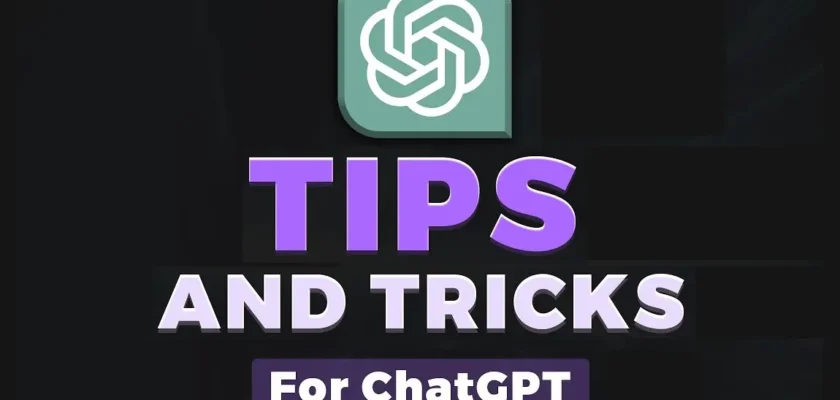Learn ChatGPT: Tips and Tricks
ChatGPT Tips and Tricks: In the bustling landscape of artificial intelligence, ChatGPT stands tall as a beacon of innovation, captivating users with its remarkable conversational abilities. As users delve deeper into the intricacies of ChatGPT, the desire to master its capabilities and unlock its full potential becomes ever more palpable. Fortunately, mastering ChatGPT is not an insurmountable challenge; with the right tips and tricks, coupled with advanced usage techniques, users can harness the power of ChatGPT to optimize for specific tasks and achieve unparalleled results.

Unleashing the Power of ChatGPT: Tips and Tricks
Understanding Prompt Engineering: At the heart of effective ChatGPT usage lies prompt engineering. Crafting clear, concise prompts that provide sufficient context and direction is key to eliciting accurate and relevant responses from ChatGPT. Experiment with different prompt styles, varying the length and specificity to find the optimal approach for your needs.
Tip: Start with broad prompts and gradually add specificity as needed. This iterative approach allows you to refine your prompts based on ChatGPT’s responses and adjust accordingly.
Exploring Contextual Prompts: Context is king when it comes to ChatGPT interactions. By providing relevant context within your prompts, you can guide ChatGPT towards generating more coherent and contextually appropriate responses. Incorporate relevant information, references, or previous conversation snippets to enrich the dialogue and steer ChatGPT in the desired direction.
Tip: Use the “prepend” technique to add context to your prompts. Prepending relevant information or cues before your main prompt can provide ChatGPT with valuable context, enhancing the quality of its responses.
Fine-Tuning Response Quality: ChatGPT’s responses are only as good as the data it has been trained on. To enhance response quality, consider fine-tuning ChatGPT on specific datasets or domains relevant to your use case. Fine-tuning allows you to tailor ChatGPT’s responses to specific contexts, improving relevance and accuracy.
Tip: Experiment with fine-tuning on smaller, domain-specific datasets to achieve more targeted results. By focusing on specific domains, you can train ChatGPT to excel in niche areas and produce highly relevant responses.
Advanced Usage Techniques: Pushing the Boundaries of ChatGPT
Exploring Conditional Generation: Conditional generation opens up a world of possibilities for ChatGPT users. By conditioning responses on specific input parameters or constraints, users can guide ChatGPT to generate responses tailored to particular scenarios or contexts. Explore conditional generation techniques such as temperature sampling, nucleus sampling, and top-k sampling to control the diversity and creativity of ChatGPT’s responses.
Tip: Experiment with different sampling techniques to strike the right balance between coherence and novelty in ChatGPT’s responses. Adjusting parameters such as temperature and nucleus size can influence the diversity and randomness of generated text, allowing for greater control over the output.
Harnessing Transfer Learning: Transfer learning offers a powerful approach to leverage pre-trained ChatGPT models for specific tasks or domains. By fine-tuning pre-trained models on task-specific data, users can quickly adapt ChatGPT to excel in diverse applications, from sentiment analysis and summarization to language translation and code generation.
Tip: Start with a pre-trained ChatGPT model such as GPT-3 and fine-tune it on task-specific datasets using transfer learning techniques. Transfer learning allows you to benefit from the general language understanding capabilities of pre-trained models while tailoring them to specific tasks or domains.
Integrating External Knowledge: Augmenting ChatGPT’s knowledge with external sources can enhance its understanding and enrich its responses. Explore techniques for integrating external knowledge sources such as knowledge graphs, databases, or APIs into ChatGPT interactions. By accessing external knowledge during conversation generation, ChatGPT can provide more informative and contextually relevant responses.
Tip: Develop custom pipelines or modules to seamlessly integrate external knowledge sources into ChatGPT interactions. Design workflows that enable ChatGPT to query external sources dynamically based on the context of the conversation, enriching its responses with up-to-date information.
Optimizing for Specific Tasks: Tailoring ChatGPT for Success
Task-Specific Prompt Design: Tailoring prompts to specific tasks is essential for maximizing ChatGPT’s effectiveness. Design prompts that align with the goals and requirements of the task at hand, providing clear instructions and context to guide ChatGPT towards desired outcomes. Experiment with different prompt formats and structures to optimize performance for specific tasks such as text generation, question answering, or content summarization.
Tip: Use task-specific keywords or cues in your prompts to signal to ChatGPT the nature of the task and the type of response expected. By embedding task-specific instructions within prompts, you can direct ChatGPT’s attention and tailor its responses accordingly.
Fine-Tuning for Task Performance: Fine-tuning ChatGPT on task-specific datasets can significantly improve its performance on targeted tasks. Select or collect datasets that are representative of the task domain and fine-tune ChatGPT using transfer learning techniques. Fine-tuning allows ChatGPT to adapt its language model to better understand and generate content relevant to the task, leading to more accurate and contextually appropriate responses.
Tip: Evaluate fine-tuned models on task-specific evaluation metrics to assess performance and identify areas for improvement. Iteratively fine-tune ChatGPT based on evaluation results, adjusting hyperparameters and training procedures as needed to achieve optimal task performance.
Continuous Evaluation and Iteration: Optimizing ChatGPT for specific tasks is an iterative process that requires continuous evaluation and refinement. Regularly assess ChatGPT’s performance on task-related benchmarks and real-world use cases, gathering feedback from users and stakeholders to identify strengths, weaknesses, and areas for improvement. Iterate on prompt design, fine-tuning strategies, and model configurations to enhance task performance and user satisfaction over time.
Tip: Establish a feedback loop for collecting user feedback and monitoring ChatGPT’s performance in production environments. Incorporate user feedback and evaluation results into ongoing optimization efforts, ensuring that ChatGPT remains aligned with evolving task requirements and user expectations.

Mastering ChatGPT is a journey of exploration and experimentation, guided by insights, innovation, and a relentless pursuit of excellence. By leveraging tips and tricks, advanced usage techniques, and task-specific optimizations, users can unlock the full potential of ChatGPT and push the boundaries of what is possible in natural language processing. With dedication and ingenuity, the possibilities are limitless, and the future of ChatGPT usage is filled with promise and potential.
Dive into the Well of your Thoughts and Let’s Paint our Digital Canvas Together! ️
Your Musings, Questions, or Simple Hellos are the Strokes that Shape our Shared Narrative. ✨ Click “Contact Me” to Contribute, and Don’t Forget to Leave a Comment Below!
Until our Next Masterpiece, Keep Reading! ✨
– Sudhir Soni

